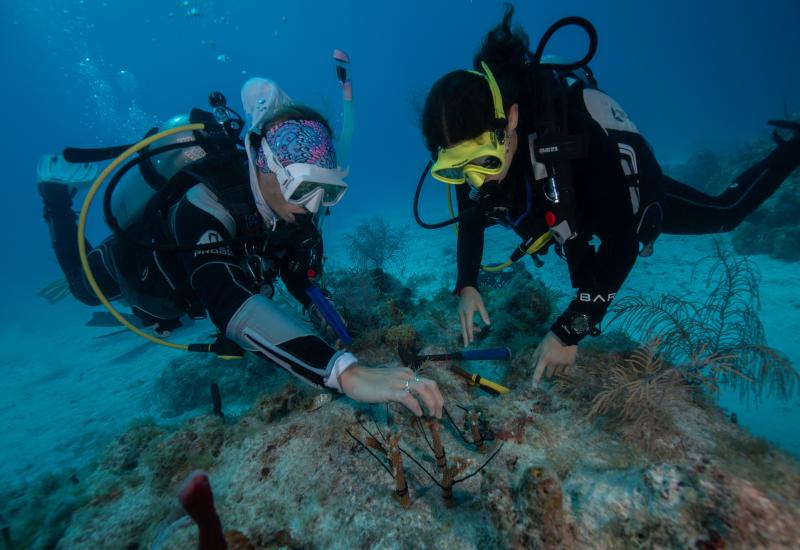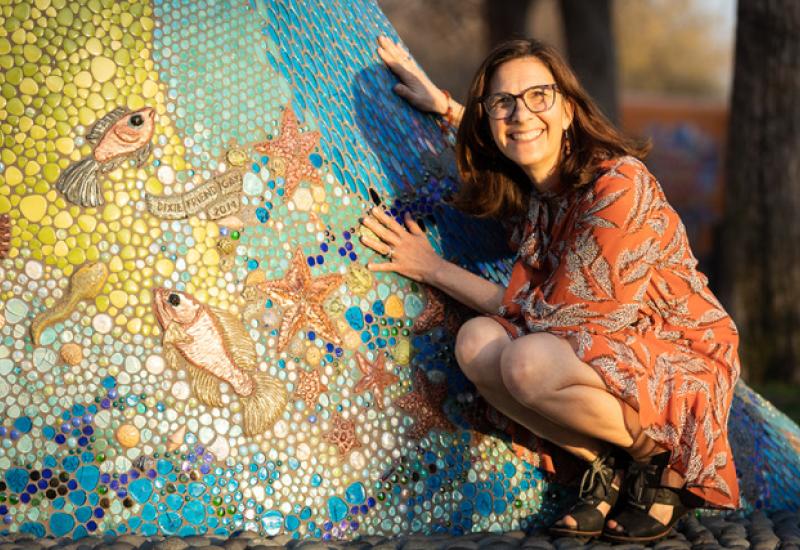An Ode to Coral Reefs

Patrick WebsterA whitemouth moray sits in its hard Porites coral kingdom off the coast of Kona, Hawaii.
What did the coral reef say to the subsiding volcanic island?
“Hey, mind if I build a ring of myself around you? It’s no problem, atoll!”
Or at least that’s what Charles Darwin surmised, in a few more words, on his five-year journey aboard HMS Beagle in 1831.Before achieving fame from his theory of evolution, Darwin remarked that atolls—the rings of stony corals encircling their cerulean lagoons—must have grown on the flanks of submerged volcanoes.
On those atolls, a special bond between land and sea became apparent to Darwin: Within coral reefs exists an intimate marriage of land and sea, wed by a shimmering ring of life.
One would think from their superlative planetary prominence that coral reefs must have been a feature for most of our ocean’s living history. They are said to be visible from space, contain 25 percent of all known marine species, and be among the most productive ecosystems, after all. But the appearance of modern corals has been difficult to pin down—it seems likely that reef-building corals and dinosaurs began their respective reigns “only” some 240 million years ago.
Related Reading: The Coral Classroom: A Lesson in Restoring Reefs and Mobilizing Action
This isn’t because the idea of a colony of cooperative clones hadn’t already been innovated many times over. Cnidarians—those stinging anemones, jellies, corals and kin—have been etching their exploits into the Book of Life for over half a billion years.Somewhere in the 400-million-years-ago range, octocorals, or “soft corals”—with their eight-tentacled polyps suspension-feeding in unison from the relative safety of their fleshy matrix—created some of the first faunal forests of coral-kind.
And there are many more claimants to the “coral” name, some still the source of substantial phylogenetic debate. The famed “fire coral” of Cozumel is more closely related to the red-eye Polyorchis bell jellyfishes of Alaska than it is to its neighboring reef-building corals.Meanwhile, Corallimorpharians like California’s temperate strawberry anemone fields have more in common with the herds of Indonesian elephant ear corals than they do with the “coral reefs” of popular parlance.
Being a stony, reef-building coral is a truly remarkable achievement and a proud feature of the Scleractinians (hard corals). Their rise to global ecological prominence likely hails from an innovative association between their polyps and photosynthetic algae known as zooxanthellae. Through symbiosis, reef-building corals became solar-powered, deriving 90 percent of their energy directly from the sun.Plugged into an inexhaustible resource and surrounded by relatively barren tropical seas compared to colder climes, reef-builders became the batteries powering local ecosystems, with particular success in the Indo-Pacific’s Coral Triangle, where 75 percent of reef-building species can be found.
And it is this special association between zooxanthellae and reef-building corals that is of specific concern to us modern explorers of these warming oceans. When corals are stressed, especially by temperature, they will expel their current zooxanthellae in the hopes of recruiting more heat-tolerant endosymbionts.During this process, the coral’s brilliant colors of golden browns and glorious greens leave with the algae, and just the clear polyps and their bright calcium-carbonate exoskeleton remain. The resulting bleached-white reef is a sign of a stressed ecosystem—the corals can recover, but it’s a long shot.Increasingly common and persistent bleach-inducing marine conditions—like the 100-degree water off Florida earlier this year—are an existential crisis for these animals that can outbuild volcanism.
Related Reading: Scientists Discover Surprising News About the Fate of Coral Reefs in the Tropical Pacific Ocean
In a relatively short time, these ecosystems have transformed our planet, gifting us the sustaining life-scapes of our diving desires and countless human livelihoods.And “all” it took was a paradigm shift: tapping directly into the sun’s energy. Maybe there’s a lesson there, too, for our own symbiosis with this living planet—perhaps with just a few slight changes to our energetic portfolios, we could build sustaining infrastructure that outlasts the erosive power of geologic time.










